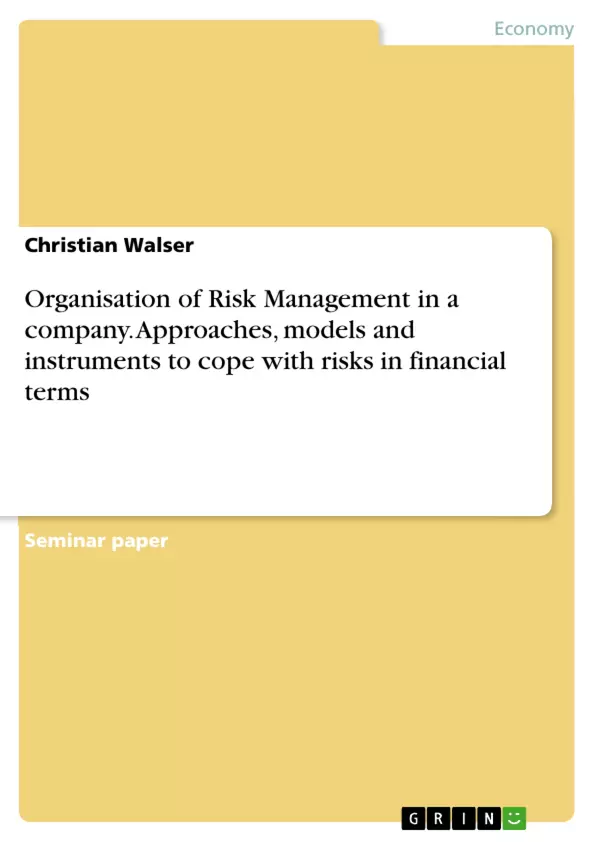This paper intends to give an overview about the different types of risks in the banking branch. A short explanation of the four most notable risks is given, which are: Credit risk, market risk, operational risk and liquidity risk.
The paper focuses on the two most important types of risk a bank has to cope with (credit risk and market risk). For this purpose some tools for risk measurement will be introduced before some approaches in respect of mitigation are shown, focusing on derivative procucts.
Last but not least a possible risk management organization is shown, using an Enterprise-wide Risk Management example.
Inhaltsverzeichnis (Table of Contents)
- Abstract
- Chapter 1: Introduction
- 1.1 Definition of Risk Management
- 1.2 Evolution of Risk Management
- Chapter 2: Several Type of Risks a Company has to Cope with
- 2.1 Credit Risk
- 2.2 Market Risk
- 2.3 Operational Risk
- 2.4 Liquidity Risk
- Chapter 3: Approaches to Cope with Risk
- 3.1 Risk Measurement
- 3.1.1 Value at Risk
- 3.1.2 Stress Testing
- 3.2 Risk Mitigation Instruments
- 3.2.1 Derivatives
- 3.2.1.1 Derivatives for Handling Market Exposure
- 3.2.1.2 Derivatives for Handling Credit Risk Exposure
- 3.2.2 Credit Scoring
- 3.2.1 Derivatives
- 3.1 Risk Measurement
- Chapter 4: Organisation of a Risk Management within a Company
- 4.1 Enterprise-wide Risk Management
- References
Zielsetzung und Themenschwerpunkte (Objectives and Key Themes)
This paper explores the various types of risks encountered in the banking industry. It focuses on the two most significant risks for banks: credit risk and market risk. The paper aims to provide an understanding of these risks and to present approaches for managing them, specifically using derivative products. It also showcases a potential risk management organization structure through an example of Enterprise-wide Risk Management.- Definition and evolution of risk management
- Types of risks in banking: credit risk, market risk, operational risk, and liquidity risk
- Tools for risk measurement
- Risk mitigation instruments, including derivatives
- Organization of risk management within a company
Zusammenfassung der Kapitel (Chapter Summaries)
- Chapter 1: Introduction - This chapter provides a definition of risk management in the context of financial institutions. It discusses the historical evolution of risk management, emphasizing the importance of managing credit risk to prevent major banking disasters. The chapter highlights the significance of risk management for maximizing shareholder value and the potential consequences of neglecting it.
- Chapter 2: Several Type of Risks a Company has to Cope with - This chapter outlines the four primary types of risk that companies face: credit risk, market risk, operational risk, and liquidity risk. It gives a brief explanation of each type of risk and its potential impact on a company's financial health.
- Chapter 3: Approaches to Cope with Risk - This chapter explores approaches to managing risk, focusing on risk measurement and mitigation instruments. The chapter introduces tools like Value at Risk and stress testing for risk measurement. It then delves into the use of derivatives as risk mitigation instruments, specifically their application in handling market and credit risk exposures. The chapter also discusses credit scoring as a tool for mitigating credit risk.
- Chapter 4: Organisation of a Risk Management within a Company - This chapter focuses on the organization of a risk management system within a company. It presents the concept of Enterprise-wide Risk Management as a comprehensive approach to managing risks across all aspects of the company.
Schlüsselwörter (Keywords)
The paper's core focus lies on the realm of risk management, specifically in a banking context. The key themes include understanding different types of risks like credit risk, market risk, operational risk, and liquidity risk, and how to manage these risks effectively. This involves exploring various tools and techniques for risk measurement and mitigation, particularly derivatives. The paper emphasizes the importance of a structured risk management organization, highlighting the benefits of an Enterprise-wide Risk Management approach.
Excerpt out of 19 pages
- scroll top
- Quote paper
- Christian Walser (Author), 2005, Organisation of Risk Management in a company. Approaches, models and instruments to cope with risks in financial terms, Munich, GRIN Verlag, https://www.grin.com/document/42751
Look inside the ebook



